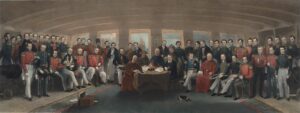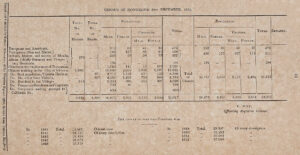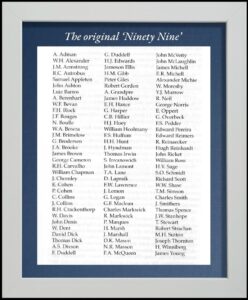The history of the Royal Hong Kong Auxiliary Air Force, and by extension the Government Flying Service, reaches back almost to the very beginning of Hong Kong itself. Over the years there have been many incarnations of what the original ninety-nine concerned citizens volunteered for, leading to the Hong Kong Auxiliary Air Force, the Royal Hong Kong Auxiliary Air Force, and finally the Government Flying Service.
Relations between Britain and China in the early 1830s became fractious, mainly because of the use of opium by Britain to fund its trade with China. In earlier centuries, opium was utilised as a medicine with anaesthetic qualities, but new Chinese practices of smoking opium recreationally increased demand tremendously and often led to smokers developing addictions. Successive Chinese emperors issued edicts making opium illegal, but imports continued to grow as smugglers and colluding officials in China sought profit. The Daoguang Emperor then charged Governor General Lin Zexu with ending the opium trade. In 1839, he published in Canton an open letter to Queen Victoria, requesting her cooperation in halting the opium trade. It is understood the letter was never read by the Queen but It was published in The Times as a direct appeal to the British public for their cooperation.
Aggressive action by the Chinese authorities in trying to end the opium trade led to London sending an expeditionary force to the region at the hands of Captain Charles Elliot of the Royal Navy and Captain Anthony Blaxland Stransham of the Royal Marines. This led to what became known as the First Opium War (1839 – 1842). After a series of defeats by the Chinese, Hong Kong Island was occupied by the British on 20th January 1841, with Commodore Sir Gordon Bremer raising the Union Flag over Possession Point, claiming Hong Kong as a colony on 26th January 1841. The First Opium War ended with the Treaty of Nanking. This was ratified by the Daoguang Emperor on 27th October and Queen Victoria 28th December. Ratification was exchanged in Hong Kong on 26th June 1843. The terms of the treaty included the ceding of the island of Hong Kong and surrounding smaller islands to Britain.
 |
| Thus Hong Kong was established as a British colony. |
With the threat from marauding pirates a hazard on the China coast the security situation in Hong Kong during the mid-1800s was such that on 30th May 1854 Sir William Caine, the Lieutenant-Governor administering the colony, on the advice of the Legislative Council, enacted (Ordinance No. 1 of 1854) to “Raise an Additional Police Rate”. This was to raise funds to establish a corps of volunteers in the form of an Auxiliary Police Force. On the same day, the following was circulated to the citizens of Hongkong:-
CIRCULAR
Colonial Secretary’s Office, Victoria.
Hongkong, 30th May, 1854.
The exigencies of the public service having compelled His Excellency The Rear-Admiral to withdraw for a time the protection afforded by a Naval Force, The Honorable the Lieutenant-Governor has had under his anxious consideration the defenceless state of the Colony and the calamities that might ensue were it attacked in its present condition by the Naval power of an enemy or by one of the formidable piratical Fleets known to be in the neighbourhood.
The peculiar composition of the Chinese population of the place renders probable also another danger of no minor importance, that of a combination of the vagrant Inhabitants for purposes of plunder whenever they may find the troops and the police engaged by the absorbing occupation of preparation for an enemy.
Under these circumstances The Lieutenant-Governor calls upon the faithful inhabitants of this Colony to lend him their aid in this emergency by forming themselves into a Corps of Volunteers for the defence of the lives and property of themselves and their families, on the occurrence of any of the abovementioned contingencies.
The honourable Colonel Griffin, Commanding the Forces, has kindly promised to make the requisite arrangements for the equipment and drilling of the Corps.
* * * * * * * *
By Order,
(signed,) C B HILLIER
Officiating Colonial Secretary.
At the time, the population of Hongkong stood at approximately 46,000, including an estimated 1,500 Europeans and Americans. The number of adult European males stood at just over 300. Of these, ninety-nine worthy gentlemen responded to the call for volunteers. Placed in this context can be seen the very strong level of support which the new body attracted from the outset. And so the Hong Kong Corps of Volunteers was established.
 |
When the threat of war in Europe receded, and Regular units of the British Army were once again able to resume responsibility for the security of Hong Kong, on the 5th July of the same year Sir William Caine considered the situation in the colony more secure and disbanded the corps.
Having once more felt the need for support for the regular authorities, on 17th March 1862 Governor, Sir Hercules Robinson, on the advice of the Legislative Council, enacted (Ordinance No. 2 of 1862) again calling for volunteers. This received the same level of enthusiastic response as previously and a new corps was formed, called the Hongkong Volunteers. In 1866, Sir Hercules Robinson having left Hongkong to assume duties as Governor of Ceylon, Colonial Secretary William Thomas Mercer as Acting Governor of Hongkong disbanded the Hongkong Volunteers as no longer necessary.
In 1878 Governor Sir John Pope Hennessy reformed the corps with the title Hongkong Artillery and Rifle Volunteer Corps.
To regularise the standing of the Hongkong Volunteers, on 13th December 1882 (Ordinance No. 18 of 1882), called “The Volunteer Ordinance”, was enacted and (Ordinance No. 2 of 1862) repealed.
In 1893 once again new legislation became necessary and on the authority of Governor Sir William Robinson (Ordinance No. 6 of 1893) repealed (Ordinance No. 18 of 1882) and authorised the Volunteer Corps together with the Coast Defence Volunteers.
On 16th September 1910 (Ordinance No. 25 of 1910) authorised the formation of a Volunteer Reserve. Ten Years later (Ordinance No. 2 of 1920) provided for the establishment of a Volunteer Force.
(Ordinance No. 10 of 1933), on 26th May 1933 amended and consolidated the law relating to the Hong Kong Volunteer Defence Corps. In 1948 new legislation changed the title to the Hong Kong Defence Force. Having been granted by his majesty King George VI the addition of “Royal” to the title, (Ordinance No. 25 of 1951) changed the title to the Royal Hong Kong Defence Force.
On 17th December 1970 (Ordinance No. 98 of 1970), the Royal Hong Kong Regiment ordinance was enacted, and finally on the same day (Ordinance No. 99 of 1970), the Royal Hong Kong Auxiliary Air Force ordinance came into force.
On 1st March 1993 a disbandment parade was held for the Royal Hong Kong Auxiliary Air Force, with the salute being taken by Governor Chris Patten. This was followed on 31st March 1993 by the final flypast of aircraft of the Royal Hong Kong Auxiliary Air Force, with Honorary Air Commodore Ross Penlington marking the occasion by firing the Jardine noonday gun at Causeway Bay, ensuring the unit went out with a bang. Later that day the unit standard was laid up at St John’s Cathedral. At midnight the Royal Hong Kong Auxiliary Air Force morphed into the Government Flying Service.
The 2nd September 1995 saw the end of active service for the Royal Hong Kong Regiment when the disbandment parade saw its members march off into the sunset, heads held high, leaving behind a proud history.
Throughout the years the formation of the various corps of volunteers required legal approval. In many cases this entailed the enactment of new legislation, copies of which are repeated below. On other occasions changes took place by announcement in the government gazette, under authority contained in existing ordinances.
















